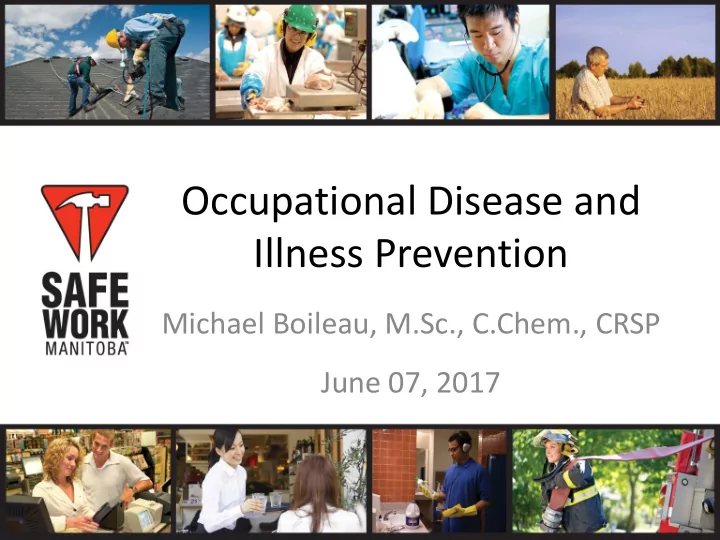

Occupational Disease and Illness Prevention Michael Boileau, M.Sc., C.Chem., CRSP June 07, 2017
What is an Occupational Disease? • Occupational diseases and illnesses are chronic health conditions that are caused by overexposure to physical and chemical hazards at work. – Silicosis – Asbestosis – Cancer
Why do we need an Occupational Disease and Illness Prevention strategy? Manitoba’s Five -Year Plan for Injury and Illness Prevention • Blueprint for change • Ten action areas
Why do we need a strategy? • Most severe of all reported WCB injuries • 224 deaths from 2000 to 2015
How was this strategy developed? • Research completed • Jurisdictional review • Inventory of MB resources • Data overview • Advisory Panel input • Draft copy completed in April, 2017 • Final approval by Prevention Committee
Jurisdictional Review • All provinces address OD issues • Some provinces do not have defined OD prevention policies • Prevention activities and enforcement • Training and resources
Inventory of MB Resources • Review existing resources and avoid duplication • Opportunity to partner • Opportunity to update existing guidelines and bulletins • Opportunity to promote RWIP
Research • Large field (many different diseases) • New chemicals are introduced everyday • Long latency periods • Employers are not certain that they are protecting their workers
Occupational Disease - Gender Gender by Accepted Occupational Disease (No MSI or Psyc) Female Male 1400 1144 1200 1045 1042 955 1000 895 Number of Diseases 834 800 600 343 400 329 314 308 308 291 200 0 2010 2011 2012 2013 2014 2015
Diseases by Age Group Diseases by Age Group (No MSIs or Psyc) 2010 2011 2012 2013 2014 2015 800 700 600 Number fo Diseases 500 400 300 200 100 0 15-24 25-34 years 35-44 years 45-54 years 55+ years
Industry Sector Occupational Disease (No MSI or Psyc) by Sector (2010- 2015) Construction, Transportation, 1114, 851, 11% 14% Healthcare, 1148, Trade, 629, 8% 15% Service, 689, 9% Manufacturing, 1447, 19% Public Administration, 1399, 18% Natural Resources, 505, 6%
Benefits • Reduce costs • Develop economically viable solutions • Benefit to industry as a whole
Monitoring • Worker participation • One day, bi-weekly • Minimal disruption to productivity • Confidentiality
Who are we trying to reach? • Employers • Workers • Public
Summary • Limited worker exposure data • Limited awareness of OD • Finite tools and resources • Lack of centralized source of info • Disconnect between OD and worker exposures
Questions
Recommend
More recommend